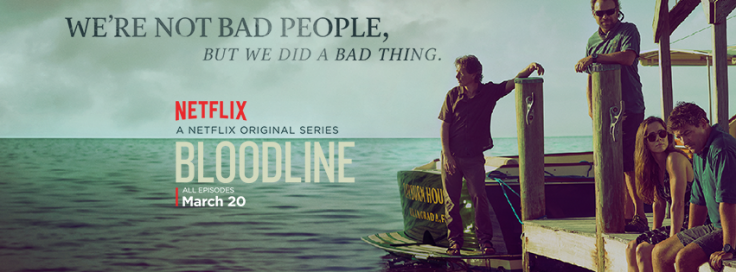
Netflix’ Bloodline and the Graduation of TV.
How television beat the movies to the top of the class.
This is the plot teaser for Bloodline: “A family of adult siblings whose secrets and scars are revealed when their black sheep brother returns home.” Its cast is led by two cult TV actors looking for a hit, an indie film darling, an aging Oscar winner and an iconic American writer/actor.
My first thoughts? This is Sundance-type movie that will gross a few million at the box office and live on in the memories of a handful of cinephiles.
I was wrong. Bloodline is a new TV series on Netflix starring Kyle Chandler, Linda Cardellini, Ben Mendelsohn, Sissy Spacek and Sam Shepard. It’s already being hailed as “your new obsession” and “the next great binge-watching show” by Huffington Post and Bustle, and its trailer reached a million views in less than 48 hours.

Just five years ago this type of hype would not have been possible for Bloodline. There’s an old idiom in the entertainment industry that goes, “Theatre is life. Cinema is art. Television is furniture.” For decades, television was seen as low-brow entertainment, not art.
The rapid erosion of this perception is well-trodden territory. Twin Peaks and The Sopranos – and, in the UK, the BBC – shattered the belief that quality is reserved for the big screen in the 90s. Shows like Breaking Bad, Mad Men and The Wire have made this quality commonplace. But the hype surrounding Bloodline goes a step further: it proves we now go to TV, not the movies, for smart entertainment.
Breaking Bad and co. broke us in. They trained us to appreciate narrative complexity, character development and precise dialogue over a protracted time frame and to find rewards in more challenging TV content. It turned out viewers were hungry for this education: Breaking Bad, which started off as a niche show averaging 1.3 million viewers in its first season, drew ratings almost ten times higher for its finale.
Tracing the roots of this change takes us, of course, straight to the Internet. Streaming has changed the way we watch TV, finally making it possible to keep up without being at home on Thursday at 9 o’clock. Better yet, it allows us to start watching a series at any point in its run and catch up, an especially crucial factor for smaller shows whose popularity depends on word of mouth. Though streaming has existed since the late 90s, we have Netflix – and others, but mostly Netflix – to thank for making it more accessible. And legal.
Netflix did much more than save us from a few lawsuits, however. After helping change the way we watch TV, it changed what we watch. Its original shows, the most notable of which being House of Cards, Orange Is the New Black and an Arrested Development reboot, are bold both in content and in delivery. By releasing full seasons at once, Netflix ensures its shows aren’t slaves to commercial breaks or constantly under the pressure of ratings, affording them creative freedom never seen before. That brand of uncompromising content will benefit Bloodline immensely.
Though big-network safe bets like Grey’s Anatomy and Two and a Half Men still do well, a shift is occurring. It’s not 1.3 million people who want the next Breaking Bad, like it was in 2008 – it’s 10.3 million. That people are excited and major media outlets are obsessed with the arrival of Bloodline is further evidence of this shift. At first blush, the commercial appeal of this series isn’t obvious: from what we can tell, it will be a slow, atmospheric family thriller with recognizable faces but no major stars. Yet it built instant anticipation, which in itself is exciting.
It’s exciting because it marks the arrival of an important cultural shift. There has always been a divide between the content of major and specialty networks, but the rise of the latter won’t be ignored by major networks much longer. The media coverage around NBC’s The Slap and ABC’s American Crime focuses heavily on how both series feel like specialty cable, and their success could usher in a change in big network programming, a change that would value creative risk for its commercial potential.
Contrast this with the pendulum swing in the movie industry. Even when we look past the superhero and young adult franchises, there is little evidence that risk or complexity lead to success. Just look at this year’s Oscar nominees: beyond the obvious and critical diversity problems, the large majority of these films are almost as formulaic as blockbusters. There are exceptions of course, but most of the films at the top of the year-end box-office – even the highest grossing indies – represent artistic inertia. Hollywood has successfully taught audiences to seek comfort and familiarity in filmmaking and to expect one type of narration, one type of pace, one type of story. Movie audiences don’t only expect the expected anymore – they demand it.
In a funny twist, commerce has shifted to film and art to television. Hollywood’s best risk-takers all flocking to TV will only accelerate the birth of a new idiom: Theatre is life. Television is art. Cinemas are buildings.
This is the plot teaser for Bloodline: “A family of adult siblings whose secrets and scars are revealed when their black sheep brother returns home.” Its cast is led by two cult TV actors looking for a hit, an indie film darling, an aging Oscar winner and an iconic American writer/actor.
My first thoughts? This is Sundance-type movie that will gross a few million at the box office and live on in the memories of a handful of cinephiles.
I was wrong. Bloodline is a new TV series on Netflix starring Kyle Chandler, Linda Cardellini, Ben Mendelsohn, Sissy Spacek and Sam Shepard. It’s already being hailed as “your new obsession” and “the next great binge-watching show” by Huffington Post and Bustle, and its trailer reached a million views in less than 48 hours.

Image - Photo: “Bloodline/Facebook”
Just five years ago this type of hype would not have been possible for Bloodline. There’s an old idiom in the entertainment industry that goes, “Theatre is life. Cinema is art. Television is furniture.” For decades, television was seen as low-brow entertainment, not art.
The rapid erosion of this perception is well-trodden territory. Twin Peaks and The Sopranos – and, in the UK, the BBC – shattered the belief that quality is reserved for the big screen in the 90s. Shows like Breaking Bad, Mad Men and The Wire have made this quality commonplace. But the hype surrounding Bloodline goes a step further: it proves we now go to TV, not the movies, for smart entertainment.
Breaking Bad and co. broke us in. They trained us to appreciate narrative complexity, character development and precise dialogue over a protracted time frame and to find rewards in more challenging TV content. It turned out viewers were hungry for this education: Breaking Bad, which started off as a niche show averaging 1.3 million viewers in its first season, drew ratings almost ten times higher for its finale.
Tracing the roots of this change takes us, of course, straight to the Internet. Streaming has changed the way we watch TV, finally making it possible to keep up without being at home on Thursday at 9 o’clock. Better yet, it allows us to start watching a series at any point in its run and catch up, an especially crucial factor for smaller shows whose popularity depends on word of mouth. Though streaming has existed since the late 90s, we have Netflix – and others, but mostly Netflix – to thank for making it more accessible. And legal.
Netflix did much more than save us from a few lawsuits, however. After helping change the way we watch TV, it changed what we watch. Its original shows, the most notable of which being House of Cards, Orange Is the New Black and an Arrested Development reboot, are bold both in content and in delivery. By releasing full seasons at once, Netflix ensures its shows aren’t slaves to commercial breaks or constantly under the pressure of ratings, affording them creative freedom never seen before. That brand of uncompromising content will benefit Bloodline immensely.
Though big-network safe bets like Grey’s Anatomy and Two and a Half Men still do well, a shift is occurring. It’s not 1.3 million people who want the next Breaking Bad, like it was in 2008 - it’s 10.3 million. That people are excited and major media outlets are obsessed with the arrival of Bloodline is further evidence of this shift. At first blush, the commercial appeal of this series isn’t obvious: from what we can tell, it will be a slow, atmospheric family thriller with recognizable faces but no major stars. Yet it built instant anticipation, which in itself is exciting.
It’s exciting because it marks the arrival of an important cultural shift. There has always been a divide between the content of major and specialty networks, but the rise of the latter won’t be ignored by major networks much longer. The media coverage around NBC’s The Slap and ABC’s American Crime focuses heavily on how both series feel like specialty cable, and their success could usher in a change in big network programming, a change that would value creative risk for its commercial potential.
Contrast this with the pendulum swing in the movie industry. Even when we look past the superhero and young adult franchises, there is little evidence that risk or complexity lead to success. Just look at this year’s Oscar nominees: beyond the obvious and critical diversity problems, the large majority of these films are almost as formulaic as blockbusters. There are exceptions of course, but most of the films at the top of the year-end box-office – even the highest grossing indies – represent artistic inertia. Hollywood has successfully taught audiences to seek comfort and familiarity in filmmaking and to expect one type of narration, one type of pace, one type of story. Movie audiences don’t only expect the expected anymore - they demand it.
In a funny twist, commerce has shifted to film and art to television. Hollywood’s best risk-takers all flocking to TV will only accelerate the birth of a new idiom: Theatre is life. Television is art. Cinemas are buildings.
